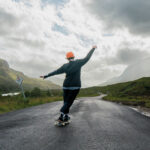Hole-in-one scalability

Posted on Sep 28, 2023 by FEED Staff
Getting a live multicamera outdoor event production to air is a tangle of logistics. Dejero offers ways to effortlessly de-tangle those workflows
Sponsored editorial
This year’s Media Production and Technology Show in Olympia London hosted a panel session – ‘Hitting an Ace: The Power of Private Networks for Live Sports Coverage’ – that took a deep dive into the many demands of traditional, live, wide-area TV infrastructures. Michael Dugard, director at broadcast facilities supplier Prolink TV, and Dejero’s sales account manager, Sukhvir Grewal, described an alternative to traditional event rigging which they had already applied to a recent golf tournament. Rather than laying a physical infrastructure, they blended private 5G networks with a range of network paths for ultra-dependable, low-latency connectivity.
The golf course involved spreads across approximately 200 acres, which means substantial cabling and rigging; 30km of cabling typically takes seven days to set up and four days to de-rig. Long cable runs also pose health and safety risks, and cables are irresistible to squirrels and other rodents, which means each one must be manually checked every day. Coupled with the transportation of cabling, generators, hoists and buggies, wired connectivity across open spaces is hugely labour- and cost-intensive. It’s no surprise that only the biggest events can justify this level of resources.
Reliable wireless connectivity for live productions can be difficult to secure in outdoor spaces. Meanwhile, thousands of visitors competing for the same bandwidth can put the available networks under significant pressure.
No event size limits
Blending private 5G mesh networks with public 5G provides an additional layer of assured connectivity. Dejero’s existing relationships with multiple international licensing partners and diverse network providers means that its clients can quickly, easily set up a local 5G mast for multicam streaming.
A single mast will support site-wide connectivity for 12 simultaneous 10Mbps cameras at as low as 500ms latency, and with no dropouts. With this in place, scalability is simply a mathematical exercise, and the same model can be applied to any broadcast model operating over a wide area and with hostile geographical elements.
Dejero Smart Blending Technology ensures dependable onsite backhaul by aggregating multiple IP networks across cellular, satellite and fibre connections, dynamically managing bandwidth, packet loss and latency differences in real time. It creates a network of networks, ensuring a more robust bandwidth than a single provider can deliver. This opens the door to cover more niche events such as second-tier sports, enabling broadcasters to maintain professional coverage at even lower costs.
Get up to par
Combining public connectivity with Dejero’s private 5G networks could significantly lower production costs. It drives down installation, decreases set-up times, minimises the number of staff required,
cuts both travel and accommodation, significantly reduces cabling and speeds up the production process for the creation of on-site highlight packages. Now that is something worth supporting.
Originally published in the Autumn 2023 issue of FEED.











